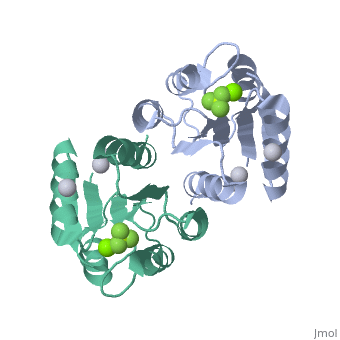PhoP-PhoQ
From Proteopedia
Contents |
Introduction
PhoP-PhoQ is a two component regulatory system found in some gram-negative bacteria such as Escherichia coli[1], Salmonella enterica[2], and Yersinia pestis[3]. In a classic two component regulatory system, there exists a sensor kinase and a response regulator[1]. In the phoP-phoQ system, phoQ acts as the sensor kinase and phoP acts as the response regulator. The purpose of this signal transduction system in bacteria is to modify cellular output in response to environmental signals. In response to particular environmental stimuli, such as a low [Mg2+], the sensor kinase, phoQ autophosphorylates. Phosphorylated phoQ then transphosphorylates the response regulator, phoP, which in turn binds DNA and modulates transcription.[1]
| |||||||||||
PhoP-PhoQ and Virulence
Most known virulence factors have been isolated by designing laboratory conditions that presumably stimulate environmental signals present in host tissues. However, many pathogenic bacteria do not express their virulence factors until specific host signals are detected, signals which are near impossible to accurately reproduce in a laboratory. To overcome this, a new approach entitled IVET (in vivo expression technology) has been developed. IVET uses animal tissue as the selective medium to enrich bacterial virulence factors specifically induced during infection.[3]
Pathogenic bacteria seldom express virulence genes constitutively, they instead need to be able to express the correct virulence genes in the correct environment. Not all virulence factors confer a selective advantage to the microbe at the same stage of infection. Thus, it is the job of the phoP-phoQ system to modulate virulence gene expression according to the cellular micro-environment.[1]
A particular and well studied environmental factor relative to the phoP-phoQ system is [Mg2+]. In response to low [Mg2+], such as would be found inside a macrophage phagosome, phoQ autophosphorylates and transphorphorylates phoP. PhoP then binds to the bacterial DNA and simultaneously activates the expression of pags (phoP activated genes) and represses the expression of prgs (phoP repressed genes). Among the gene products of pags are proteins necessary to survive inside the macrophage, a critical stage of Salmonella Typhirium virulence. Among the gene products of prgs are proteins necessary for invasion and infection of the host, which are less important once in a host macrophage's phagosome.
Two component regulatory systems such as phoP-phoQ are obviously an attractive target for future antimicrobial drugs. If the phoP-phoQ can be altered to a dysfunctional state, the relevant bacteria would have decreased pathogenicity and increased suceptibility to nonspecific immune defense.
3D Structures of PhoP-PhoQ
PhoP
3r0j – MtPhoP – Mycobacterium tuberculosis
2pmu – MtPhoP DNA-binding domain
2pkx – EcPhoP regulatory domain (mutant) – Escherichia coli
2pl1 - EcPhoP regulatory domain (mutant) + BeF3
1mvo – PhoP N terminal – Bacillus subtilis
PhoQ
3cgy – StPhoQ catalytic domain + radicicol – Salmonella typhimurium
3cgz - StPhoQ catalytic domain
1yax - StPhoQ sensor domain (mutant)
3bq8 – EcPhoQ
3bqa – EcPhoQ (mutant)
1id0 – EcPhoQ kinase domain
References
- ↑ 1.0 1.1 1.2 Hoch JA. Two-component and phosphorelay signal transduction. Curr Opin Microbiol. 2000 Apr;3(2):165-70. PMID:10745001
- ↑ 2.0 2.1 2.2 2.3 2.4 Bachhawat P, Stock AM. Crystal structures of the receiver domain of the response regulator PhoP from Escherichia coli in the absence and presence of the phosphoryl analog beryllofluoride. J Bacteriol. 2007 Aug;189(16):5987-95. Epub 2007 Jun 1. PMID:17545283 doi:10.1128/JB.00049-07
- ↑ Angelichio MJ, Camilli A. In vivo expression technology. Infect Immun. 2002 Dec;70(12):6518-23. PMID:12438320

